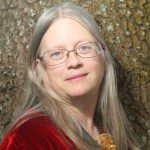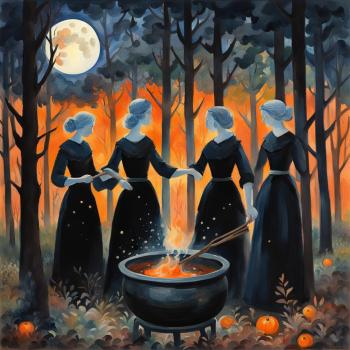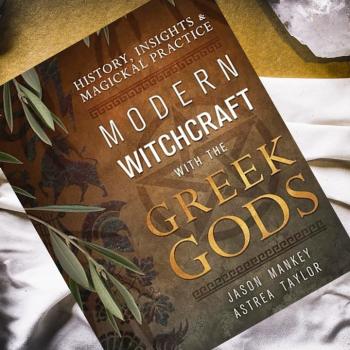Greetings, and welcome back to Wyrd Words. Keeping the Thor in Thursdays, every other week here on Agora! This week we’re tackling the Patheos Public Square challenge!
According to Robert Bellah, American civil religion is a belief system that is structured around culturally relevant holidays, rituals, and values. It is a nationalist faith that extols prophets like George Washington, Thomas Jefferson, and John Adams, and it passes along the Lore in parables of cherry trees and the first Thanksgiving, handed down from generation to generation. Its temples are the monuments to Washington and Lincoln; its liturgy is recited before class and at every football game. Bellah’s “Civil Religion” runs parallel to its theistic counterparts, unifying people of various faiths in a common drive for patriotic fervor. I believe that civil religion, as Bellah conceived of it, may not be dead (yet), but it’s certainly not the same anymore.
Anthony D. Smith wrote a book called Chosen Peoples: Sacred Sources of National Identity, which addresses the concepts of nationalism and civil religion. The essence of Smith’s proposal is that civil and theistic communities are related social organisms, with some very fundamental aspects of human psychology acting as a kind of common ancestor. The idea of gathering into communities beyond the scale of extended familial bonds was the greatest and most fundamental social achievement ever accomplished by humanity. It allowed us to move up from small family troupes and work as larger units to accomplish infinitely more complex tasks as a civilization. Moving beyond that small, familial scale required humanity to acknowledge and embrace other unifying ideas beyond immediate relation. Smith supports three common bonding elements within the concept of “community”: Ethnic, Cultic, and Moral-Legal. Ethnic communities are bound together through an idea of shared ancestral bloodlines, which is essentially an extension of those early familial troupes. Cultic communities are bound together by the idea of shared religion, gods, or traditions. Finally, Moral-Legal communities are bound together by a shared set of social norms and moral ideals.
At the time when Civil Religion in America was written, we were just past the height of the Cold War, and not even out of the woods yet. Our culture had been swept away by the “Red Panic” and was still reeling from the McCarthy witch-hunts. Under the perceived threat of a foreign culture, America rushed to identify what was “properly American” and separate itself from the godless communists in any way it could. After two world wars had shown us that we needed to band together in Civil Orthopraxy, the Cold War taught us how to identify the outsider through the birth of Civilist Orthodoxy.
Many of Smith’s contemporaries argued that the modern age isn’t conducive to theistic religion, which was doomed to be driven extinct by nationalist ideals. Smith proposed that social organisms, like religion, adapt to their environment. In an age where Bellah’s civil religion was fast becoming the norm, theistic religion would have to learn a new game. Placed in a world of national borders and politics, religious communities adapted to use the borders of “The Nation” as a way to establish religious and cultural boundaries.
Civil religion today exists more as a tool to divide ourselves, separating the true believers from the heretics by promoting a constant competition to see who is MOST American. In the 2012 elections, Americans watched the various Republican candidates compete with each other, each trying to show that they were somehow more American than the others. We watched the infamous “Birthers” try again and again to support their candidate by questioning the president’s “American-ness” rather than by advertising their candidates policies.
In a particularly memorable speech, one candidate invited Pastor Dennis Terry to give the opening address at their rally. Mr. Terry sparked a fierce (if brief) controversy with the following words:
“Listen to me. If you don’t love America, and you don’t like the way we do things, I’ve got one thing to say: get out! We don’t worship Buddha, we don’t worship Mohammed, we don’t worship Allah. We worship God. We worship God’s son, Jesus Christ.”
Regardless of historical fact, these religious communities have created a rhetoric which allows them to usurp a certain amount of the social power of national identity. They utilize the nation, and nationalist sentiment, as a way to enforce an in-group/out-group, tribal mentality. If you don’t agree with their views, you are dismissed as being “un-American.” This is Civilist Orthodoxy in action.
So does America need a civil religion? I’d say America HAS a civil religion, it simply no longer does what Bellah envisioned. Can we put the cat back into the bag? Can we start over and try again for that sense of national unity? I honestly don’t think so. The foundation of any religious community is shared belief, and America’s civil religion is no different. As a culture, we may all still recognize the symbols and liturgy of Bellah’s vision, but we’ve divided ourselves into tribes, each claiming exclusive rights over those symbols. It’s no longer about what makes us all the same; instead it’s become about who “does it BEST.” Rather than looking at the flag and appreciating that we’re on the same side, the red tribe and the blue tribe point fingers at each other and fight over who has the right to hold it.
Civil religion has the potential to be a great force for motivation and unity. Unfortunately, civil religion as it has come to be practiced in America is a tool of partisan politics. Until we resolve this underlying tendency to divide ourselves, this in-group/out-group behavior, civil religion isn’t going to be able to accomplish any lasting good.
Wyrd Words is published on alternate Thursdays. Subscribe via RSS or e-mail!














